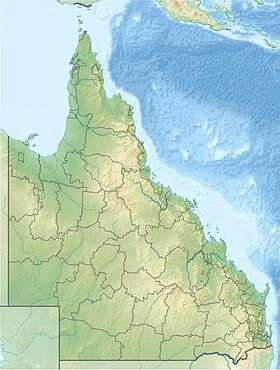Sea Hill Light
.jpg) The first little Sea Hill Lighthouse, on display at the Gladstone Maritime Museum | |
 Queensland | |
| Location |
Curtis Island Queensland Australia |
|---|---|
| Coordinates | 23°29′27.5″S 150°58′49.4″E / 23.490972°S 150.980389°ECoordinates: 23°29′27.5″S 150°58′49.4″E / 23.490972°S 150.980389°E |
| Year first constructed |
1873[1] or 1876[2] (first) 1895 (second) |
| Deactivated | 2006 |
| Construction | hardwood frame covered by corrugated galvanised iron tower |
| Tower shape | conical frustum tower with balcony and lantern |
| Markings / pattern | white tower, red lantern dome |
| Height | 13 metres (43 ft) |
| Focal height | 33 metres (108 ft) |
| Characteristic | Fl (2) W 6s. |
| Admiralty number | K3000 |
| NGA number | 111-10320 |
| ARLHS number | AUS-196 |
Sea Hill Lighthouse, also known as Sea Hill Point Light[3] Little Sea Hill Light,[4] was a lighthouse on the northwest point of Curtis Island, Queensland, Australia. Its purpose was to mark the east side of the entrance to Keppel Bay,[2] on passage to Fitzroy River and Port Alma.[1] The first lighthouse at the locations was constructed in 1873 or 1876, moved in the 1920s, and is now on display at the Gladstone Maritime Museum. A second lighthouse was constructed in 1895, deactivated in 2006 and demolished in early 2009.[2]
History

First lighthouse
The first lighthouse, constructed in 1873[1] or 1876,[2][5] was the first in Queensland of its design, made of a hardwood frame clad with corrugated iron. This design was then used in seven more lighthouses, by order of establishment, Grassy Hill Light, Goods Island Light, Bay Rock Light, Old Caloundra Light, North Point Hummock Light (demolished), Gatcombe Head Light (demolished) and Bulwer Island Light.[4] With the installation of the second lighthouse in 1895 it became the front light in the range.[6] In the 1920s, the lighthouse was relocated to Station Point, about 6 kilometres (3.7 mi) northeast. It stood there until it was deactivated in the 1960s and then sold into private hands. It is currently on display at the Gladstone Maritime Museum at 23°50′4″S 151°15′37″E / 23.83444°S 151.26028°E.[2]
The lighthouse is rather short, only 20 feet (6.1 m) in height. Unlike the other seven Queensland lighthouse towers of the corrugated iron clad type, it is hexagonal in plan, rather than round. A gallery and a lantern top the tower, and much like other Queensland lighthouses, it is painted white with a red dome.[2]


Second lighthouse
The second lighthouse was constructed in 1895 and for a while served as the rear light in the range.[6] It had a 7.87-metre-high (25.8 ft), timber framed corrugated galvanized iron clad tower, with a lantern and a balcony. The original optical apparatus was a 4th order fixed lens with kerosene wick burner. In 1930 the light was converted to acetylene lighting, with sun valve and flasher. By 1977 the original lens had been removed and a solar powered Tideland ML-300 electric beacon installed. A pilot station was established on the foreshore nearby in 1919, and closed in 1963.
2014 - the lighthouse is still there standing tall, but not kept lit.
It is visited by people interested in history and also Amateur Radio Enthusiasts during the annual International Lighthouse Lightship Weekend (ILLW) - http://illw.net/
For a few years now, members of the 'Central Queensland Amateur Radio Association inc' - http://www.cqara.org.au/ - have travelled by boat to visit the lighthouse, set up amateur radios and contacted other Amateur Radio Enthusiasts around the world also stationed at lighthouses for the International Lighthouse Lightship Weekend.
See also
Notes
References
- List of Lights, Pub. 111, The West Coasts of North and South America (Excluding Continental U.S.A. and Hawaii), Australia, Tasmania, New Zealand, and the Islands of the North and South Pacific Oceans (PDF). List of Lights. United States National Geospatial-Intelligence Agency. 2010. p. 205.
- Rowlett, Russ. "Lighthouses of Australia: Queensland's East Coast". The Lighthouse Directory. University of North Carolina at Chapel Hill. Retrieved 14 November 2010.
- "Little Sea Hill Lighthouse (entry 602784)". Queensland Heritage Register. Queensland Heritage Council. Retrieved 13 July 2015.
- Plaque next to the lighthouse at Gladstone Maritime Museum.
- "Sea Hill Point Lighthouse, Curtis Island, QLD, Australia (Place ID 101513)". Australian Heritage Database. Department of the Environment.
- Davenport, Winifred (1986). Harbours & Marine: Port and Harbour Development in Queensland from 1824 to 1985. Brisbane: Department of Harbours & Marine.
External links
| Wikimedia Commons has media related to Sea Hill Light. |
- Central Queensland Amateur Radio Association
- Central Queensland Amateur Radio Association
- youtube.com
